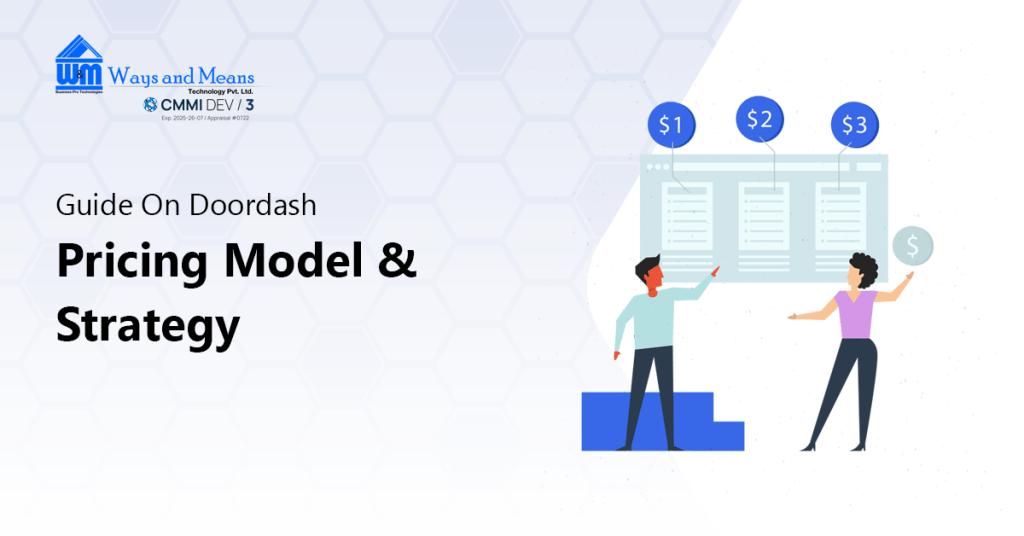- Introduction
- Introducing DoorDash: An On-Demand Logistics Startup – The beginning
- Facts and statistics about DoorDash
- The successful timeline
- Salient Features of DoorDash model
- Business Plan Interpretation
- Customer Segment of DoorDash
- The Value Preposition
- How does DoorDash Works ?
- Business Model – DoorDash
- Factors Affection Doordash Cost
- What Makes DoorDash’s Buisness Model stand out ?
- Summarizing Marketing Strategy of DoorDash
- Key Takeaway
- Future
- Frequently Asked Questions
Introduction
In this blog, we delve into the in-depth pricing model of DoorDash, the popular food delivery app. We will provide a comprehensive overview of Doordash, including its market statistics, revenue model, operation, cost, and features.
Satisfy Those Late-Night Cravings with DoorDash
We all have those late-night hunger pangs at some point, and with food delivery services, we can now satisfy these cravings at the comfort of our homes. The food business has seen a tremendous transformation with the advent of companies like Zomato, Grubhub, Seamless, and others. However, the largest food delivery service in the United States is none other than the Palo Alto-based DoorDash.
With its impressive growth, DoorDash not only offers exceptional services but also provides ample employment opportunities. Thanks to the digital boom, businesses have embraced online technology, and DoorDash is no exception.
As per the statistics, DoorDash established itself as the leading food delivery service in the US even during the pandemic crisis. With the potential for further growth and technological advancements, the future looks bright for this food delivery app developer.
If you’re seeking to develop a food delivery app like DoorDash, you’ve come to the right place!”
Introducing DoorDash: An On-Demand Logistics Startup – The beginning
DoorDash operates as a logistics-based startup, serving as the link between merchants and customers who desire products from local merchants to be delivered to their doorstep. Launched in 2013, DoorDash currently focuses solely on food delivery services.
DoorDash is a US-based food delivery service that was founded in 2013 by four Stanford students – Tony Xu, Stanley Tang, Andy Fang, and Evan Moore. It uses logistics technology to deliver food from restaurants to customers. The company started in Palo Alto and has now expanded to over 4,000 cities and 340,000 stores across the US and Canada. It is headquartered in San Francisco and has Y-Combinator support. DoorDash overtook GrubHub in 2019 as the largest third-party delivery service in the US and had a total revenue of $900 million in December 2019.
DoorDash has seen tremendous growth since its launch and is now the largest third-party food delivery service in the US. Its headquarters are located in San Francisco, California, and it operates in over 4,000 cities and 340,000 stores across America and Canada. The company uses technology and logistics to provide fast and convenient food delivery services to its customers. The four Stanford students who founded DoorDash have a background in technology and have leveraged this expertise to build a successful and innovative business. With the backing of Y-Combinator, DoorDash has become a leader in the on-demand food delivery industry and continues to grow and expand its services.
Facts and statistics about DoorDash
- 2021 annual revenue: $4.9 billion
- Q2 2022 revenue: $1.6 billion
- Number of drivers: 1 million
- Active users: 25 million
- 2021 number of orders: 1.4 billion
- 69% increase in revenue to $4.88 billion in 2021
- 2021 net loss of $468 million, $7 million more than 2020
- 25 million users, mostly from the US
- Controls 45% of the US food delivery market (according to Edison Trends)
The successful timeline
- DoorDash was founded in October 2012 by four Stanford students
- The idea was tested with a landing page called PaloAltoDelivery.com
- Y Combinator provided seed funding of $120,000 in March 2013
- DoorDash was incorporated in Delaware on May 21, 2013
- The company officially named itself DoorDash in June 2013
- $2.4 Million was raised in a seed round in October 2013 from investors including Khosla Ventures, Pejman Mar Ventures, Andy Rachleff, Russell Siegelman, Charles River Ventures, SV Angel, Paul Buchheit
- $17.3 Million was raised in a Series A round in May 2014 led by Sequoia Capital
- Sequoia Capital’s Alfred Lin joined the company’s board of directors
- DoorDash expanded to LA and Boston in 2014
- The company unveiled a new logo inspired by the Japanese bullet train in November 2014
- $40 Million was raised in a Series B round in March 2015 led by Kleiner Perkins with participation from Sequoia Capital, Khosla Ventures, and Charles River Ventures
- DoorDash launched its app on Android in April 2015
- DoorDash was sued for trademark infringement by In-N-Out in November 2015 and agreed to stop delivery from In-N-Out locations
- DoorDash expanded outside the US for the first time to Toronto, Canada in November 2015
- $127 Million was raised in a Series C round in March 2016 led by Sequoia Capital with participation from Kleiner Perkins, Khosla Ventures, Y Combinator Continuity Fund, and Wellcome Trust
- Alcohol delivery services started in Southern California in June 2016 through a partnership with Anheuser-Busch
- DoorDash Drive, a fulfillment product, was launched in December 2016
- DoorDash partnered with starship Technologies to test delivery robots in January 2017
- The company partnered with zero-emission electric bike company GenZe in April 2017 to offer bikes to employees (Dashers)
- DoorDash acquired Buying Rickshaw, a local delivery platform, in September 2017
- DoorDash introduced the group delivery system for its iOS and Android apps in September 2017
- $535 Million was raised in a funding round in March 2018 led by SoftBank Group with participation from Sequoia Capital, GIC, and Wellcome Trust
- DoorDash partnered with Walmart for grocery delivery in April 2018
- $250 Million was raised in August 2018 bringing the company’s value to $4 Billion
- By December 2018, DoorDash was the second largest food delivery company in the US behind GrubHub
- $400 Million was raised in February 2019 bringing the company’s total funding to $1.4 Billion and valuation to $7.1 Billion
- DoorDash surpassed GrubHub in total sales in March 2019
- $600 million was raised in May 2019
- DoorDash acquired Caviar, a premium food delivery service, on August 1, 2019
Salient Features of DoorDash model
- DoorDash employs its own drivers, referred to as “Dashers”.
- The delivery fee charged to customers per order ranges from $5 to $8.
- The company’s commission is almost 20%, which is paid for by the restaurants.
- DoorDash operates in over 20 markets across the United States and Canada.
- On average, Dashers working for DoorDash earn more than $600 in a calendar year in the US.
Business Plan Interpretation
- By having its own drivers, DoorDash has more control over the delivery process and can ensure a consistent level of service for customers.
- The delivery fee charged to customers helps to cover the costs of the delivery service and allows DoorDash to generate revenue.
- The commission charged to restaurants helps DoorDash to generate revenue and cover the costs of running its business.
- Operating in multiple markets allows DoorDash to reach a wider customer base and generate more revenue.
- A high average earnings for Dashers indicates that there is a strong demand for DoorDash’s delivery services and that the company is able to attract and retain a large number of drivers. This, in turn, helps to ensure that DoorDash is able to consistently meet customer demand for deliveries.
Customer Segment of DoorDash
- Users:
- Busy individuals who don’t have time to go out and dine.
- Corporate and business people who want to treat their team without affecting their work schedule.
- People who don’t want to cook.
- College students and working people without access to a kitchen.
- Restaurants:
- Restaurants without delivery services.
- Food joints with poor seating arrangements.
- Restaurants looking for more customers and online branding.
- Dashers:
- Individuals looking for a delivery job with flexible hours.
- People seeking jobs with good tips.
The Value Preposition
DoorDash has attracted significant investment interest due to its efficient revenue model. For a service like DoorDash to succeed, it must demonstrate strong returns, which is why the company has consistently won the trust of investors.
DoorDash generates revenue through the following channels:
- Business Commissions:
DoorDash offers businesses a way to reach their target audience with ease, making it possible for customers to order from their favorite restaurants, even if the restaurants do not have their delivery systems. In exchange for this service, DoorDash charges a commission from the business, typically around 20%. Restaurants are happy to pay this commission as it saves them effort.
- Delivery Fee:
DoorDash has its own delivery network and employs delivery agents, called dashers, to deliver orders placed by customers. Customers pay for the delivery, and dashers may also receive tips. DoorDash charges a commission from the businesses for delivery, as well as a delivery fee to the customer, which ranges from $5 to $8. Customers prefer to use the DoorDash app to order food from non-delivery restaurants, due to its many restaurant and dish options and user-friendly features.
- Advertising:
In addition to the previous two services, DoorDash also offers advertising services to restaurants. While restaurants are listed on the website and app for users to see, they may not receive preferential treatment and rely on user reviews. With DoorDash advertising, businesses can reach more people and come to the forefront of the ordering process. This advertising service is a crucial part of DoorDash’s revenue generation, allowing businesses to take advantage of DoorDash’s extensive reach.
This is how DoorDash generates revenue and has become the largest third-party delivery service in the USA. The company’s growth has been impressive, and it shows no signs of slowing down.
How does DoorDash Works ?
On-Demand logistics startups typically follow a similar model, but it’s the small variations that set them apart. If you’re an entrepreneur planning to start a similar business, here are important points to consider:
Order Selection: DoorDash enables users to pick their preferred food by displaying a list of restaurants with various menus. The app’s search, nearby restaurant, and category-based options make it easier for users to choose.
Payment: Once the order is placed online, users make the payment. DoorDash then sends the order to the restaurant for preparation and packing. Order
Tracking: The delivery person collects the packaged food order from the restaurant. DoorDash’s in-built software, used by the delivery driver on their phone, allows them to accept orders during their downtime. The app provides order tracking to give customers an estimate of the delivery time.
Delivery: The delivery personnel aim to shorten the delivery time as much as possible. Customers, although not mandatory, often tip the delivery personnel and they keep 100% of the tips received.
Business Model – DoorDash
Doordash’s Revenue Generation Model
For aspiring entrepreneurs interested in the on-demand logistics or food delivery sector, understanding Doordash’s revenue generation model is crucial. Doordash earns money in the following ways:
Order Commission: DoorDash delivers food orders placed by customers through its platform, for which it charges a commission on each order. Restaurants usually pay a 20% commission for this service.
Restaurant Advertising: In addition to commissions, DoorDash also earns revenue from restaurants for advertising and marketing on its app. For higher visibility, such as being at the top of the restaurant list or appearing in advanced search, DoorDash charges a fee.
Delivery Fees: DoorDash employs its own drivers, referred to as Dashers, and charges customers a delivery fee that varies based on the distance and the restaurant’s agreement with DoorDash. On average, the fee is between $5 and $8 per order.
Factors Affection Doordash Cost
- Restaurant: The prices of food from the restaurant have a significant impact on the cost of DoorDash. Some restaurants may be more expensive, while others may be cheaper. To save money, choose the right restaurant.
- Distance: The delivery distance also affects the cost of DoorDash. With the DoorDash Drive program, deliveries beyond a certain distance may incur an extra charge.
- Demand: The cost of DoorDash is also dependent on demand for its services. On days when demand is high, prices may be higher and a service fee may be applied.
In conclusion, DoorDash has a well-managed revenue and pricing model, making its profit goals clear and transparent. Every aspect of the business benefits from its services.
What Makes DoorDash’s Buisness Model stand out ?
When discussing DoorDash’s business model, it’s crucial to consider the factors that set it apart from others in the industry. DoorDash’s strong revenue in 2021 is a testament to its effective business model and strategies.
While many food delivery apps have emerged in recent years, none have seen the same level of growth as DoorDash.
So, what makes DoorDash unique compared to others in the market?
A business makes its mark by offering standout features and providing high-quality solutions to its clients. When it comes to how DoorDash operates, the process is simple and user-friendly, making it easier for customers and restaurants to connect.
Summarizing Marketing Strategy of DoorDash
- Mutual Benefits with Each Order Each order provides benefits to both the customer and the restaurant owner, strengthening their loyalty to the app.
- Identifying the Dashers DoorDash drivers, also known as Dashers, are given a unique identity that not only makes their job cooler but also helps them feel a sense of community and enjoy working with the team.
- Affordable Delivery Fees Customers can enjoy their meals at a low cost due to DoorDash’s minimal delivery fees. The best part is that these fees do not impact the Dashers, as they receive their fair share of payment.
- Commission-Based Earnings DoorDash charges restaurants an average commission of 20%, which is a major source of the company’s profits. While the amount may seem high, the brand brings in more business for the restaurants.
- Decent Pay for Dashers Dashers earn around $600 annually, which is a decent sum that can improve with tips and other services.
- Dominant Presence Operational in around 4,000 cities and partnering with over 340,000 stores in the US and Canada, DoorDash is the largest third-party delivery service in the region. Although Grubhub is its largest competitor, DoorDash has established itself as a leader in just 6 years through innovative experiments and exceptional customer service.
Key Takeaway
That concludes our overview of the revenue generation and pricing models at DoorDash. If you’re looking to develop an app like DoorDash, consider reaching out to Ways and Means Technology’s team of mobile app developers. With their expertise and experience, they can help you establish a successful and profitable app.
Throughout its history, DoorDash has focused on delivering creative and innovative services. Its commitment to experimentation and growth has attracted substantial funding, and its self-sustaining business model has made it a leader in the industry.
Future
The future of DoorDash looks promising with its continued embrace of technology. The company has recently introduced its new “Delight” score system, which provides a rating of restaurants based on delivery quality, popularity, and customer feedback, allowing customers to make informed decisions when ordering food. DoorDash has the ambition to become a leader in the food delivery industry and to this end, the Delight score will be an invaluable tool. At present, DoorDash’s focus is solely on food delivery, but in the long run, it may expand into other areas, thereby presenting a significant challenge to other players in the on-demand delivery space.
Frequently Asked Questions
What are the key features of a food delivery app like DoorDash?
Some of the key features include a user-friendly interface, real-time tracking, multiple payment options, restaurant ratings, and reviews, and integration with a mapping system to track delivery locations.
What are the important technologies used in building a food delivery app like DoorDash?
Some of the important technologies used are GPS, mapping APIs, payment gateway integration, push notifications, and real-time updates.
How does the delivery process work in a food delivery app like DoorDash?
The delivery process works by first allowing users to place an order from a participating restaurant. Then, a delivery partner or “Dasher” is assigned to pick up the order and deliver it to the user’s location. The entire process is tracked in real-time and updates are sent to the user through the app.
How does a food delivery app like DoorDash handle payment processing?
The payment processing is handled through a secure payment gateway integration. Users can choose from multiple payment options such as credit/debit cards, PayPal, or digital wallets.
What is the revenue model for a food delivery app like DoorDash?
The revenue model is usually a combination of delivery fees charged to users and commission fees charged to participating restaurants. Some food delivery apps also earn revenue through promotions and advertising.
How does a grocery delivery app differ from a food delivery app?
A grocery delivery app focuses on delivering grocery items, while a food delivery app primarily focuses on delivering meals from restaurants. Grocery delivery apps often have a wider range of products and may require additional features such as a shopping cart and grocery list management.
What are the important considerations for building a grocery delivery app?
Some of the important considerations for building a grocery delivery app include inventory management, real-time updates on product availability, secure payment processing, and efficient delivery logistics.


